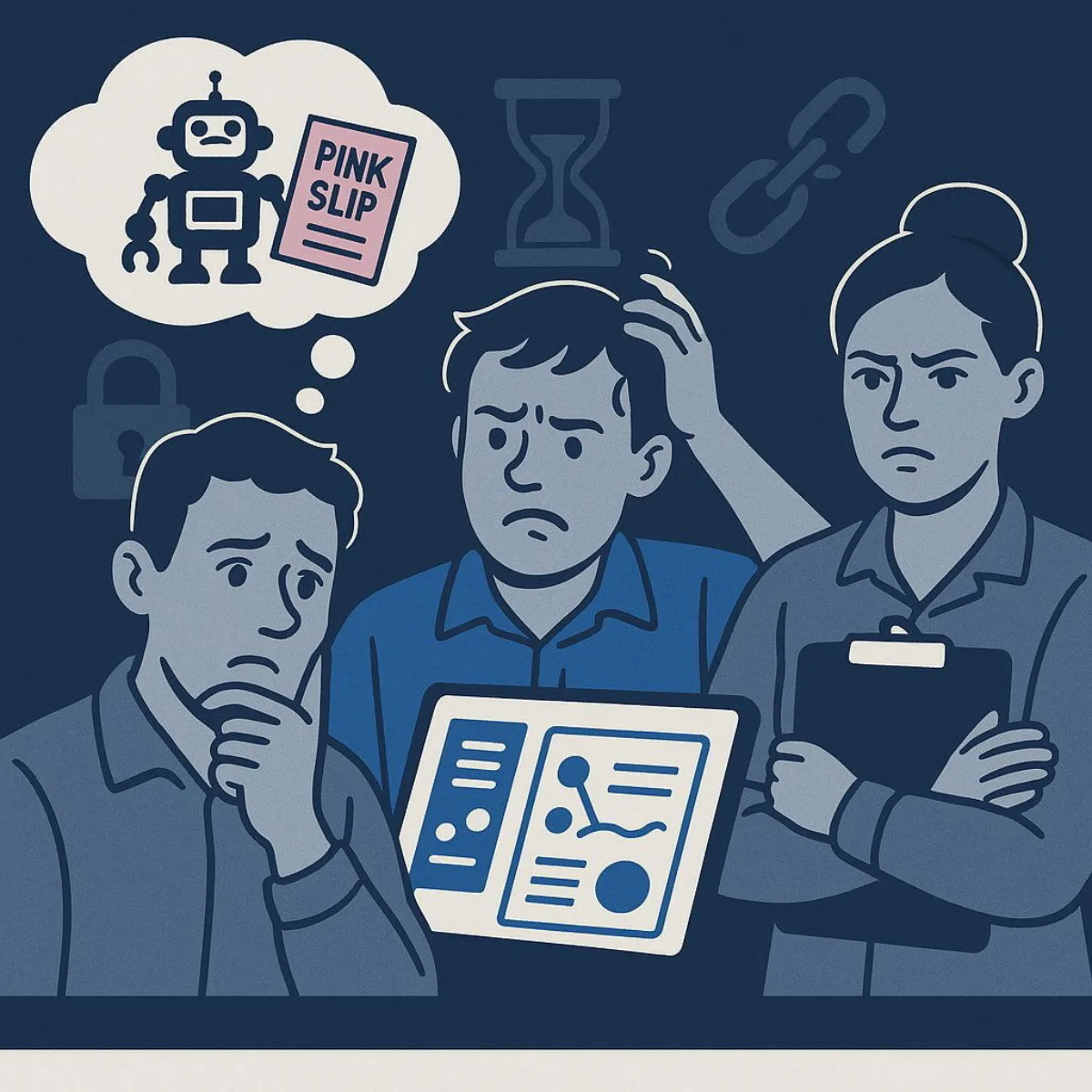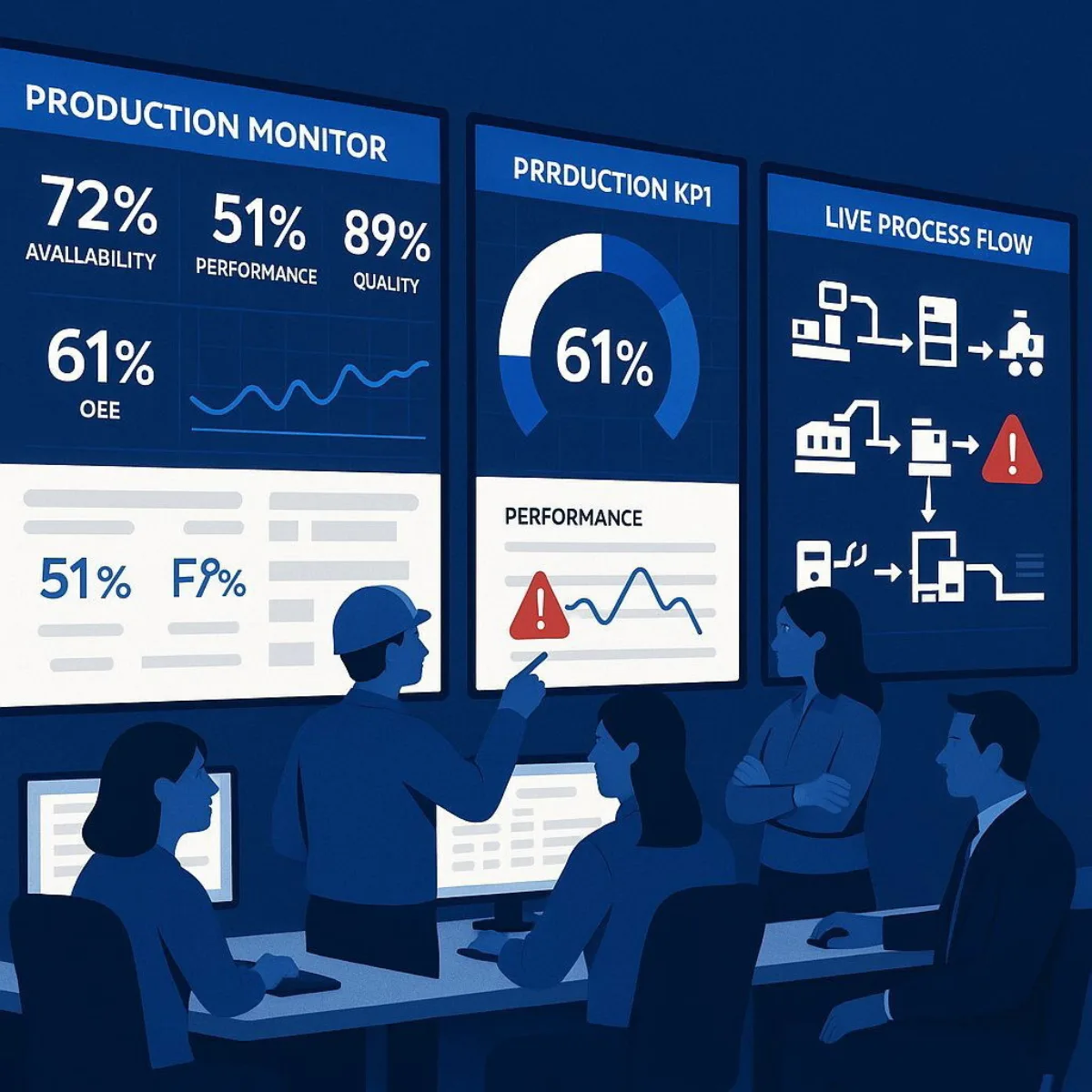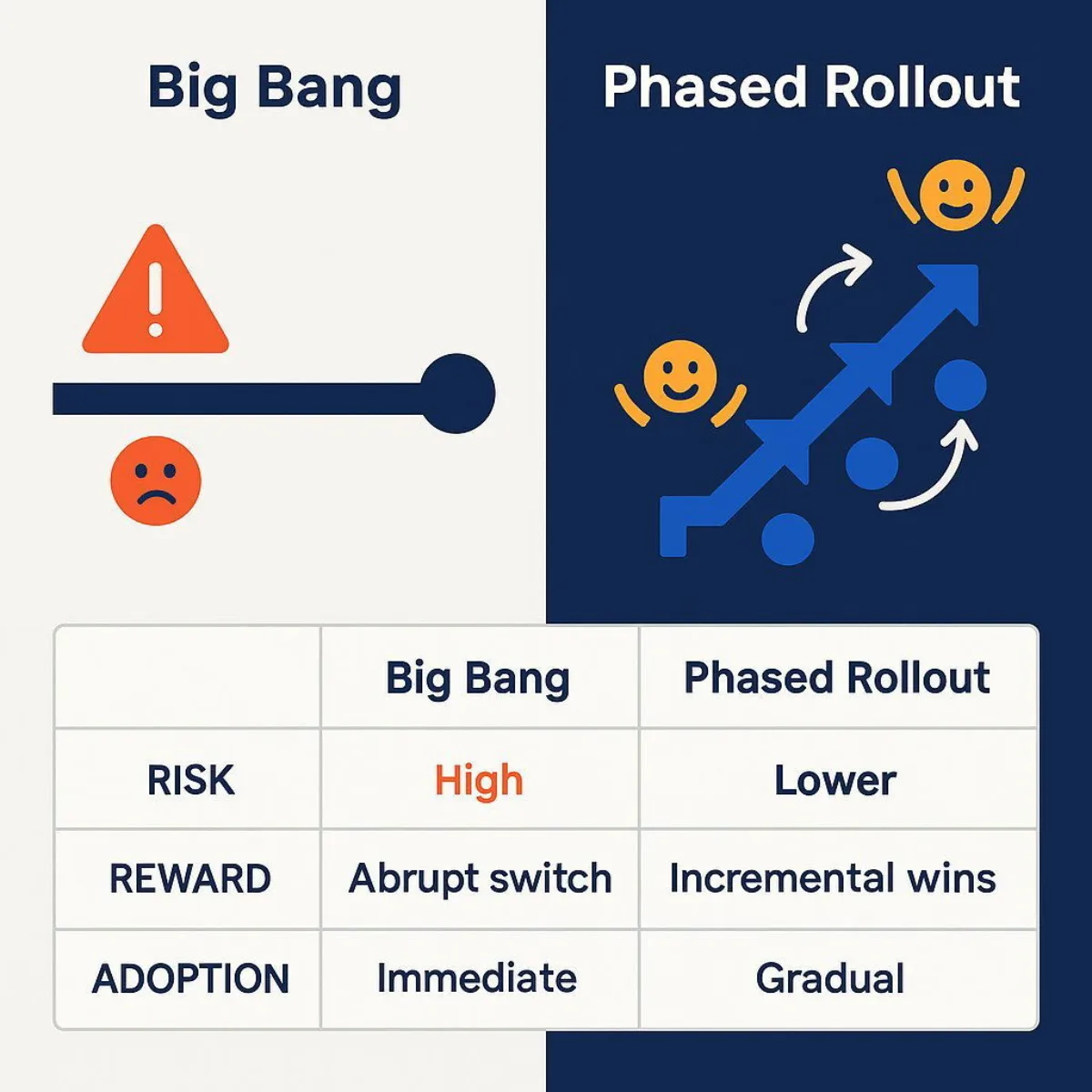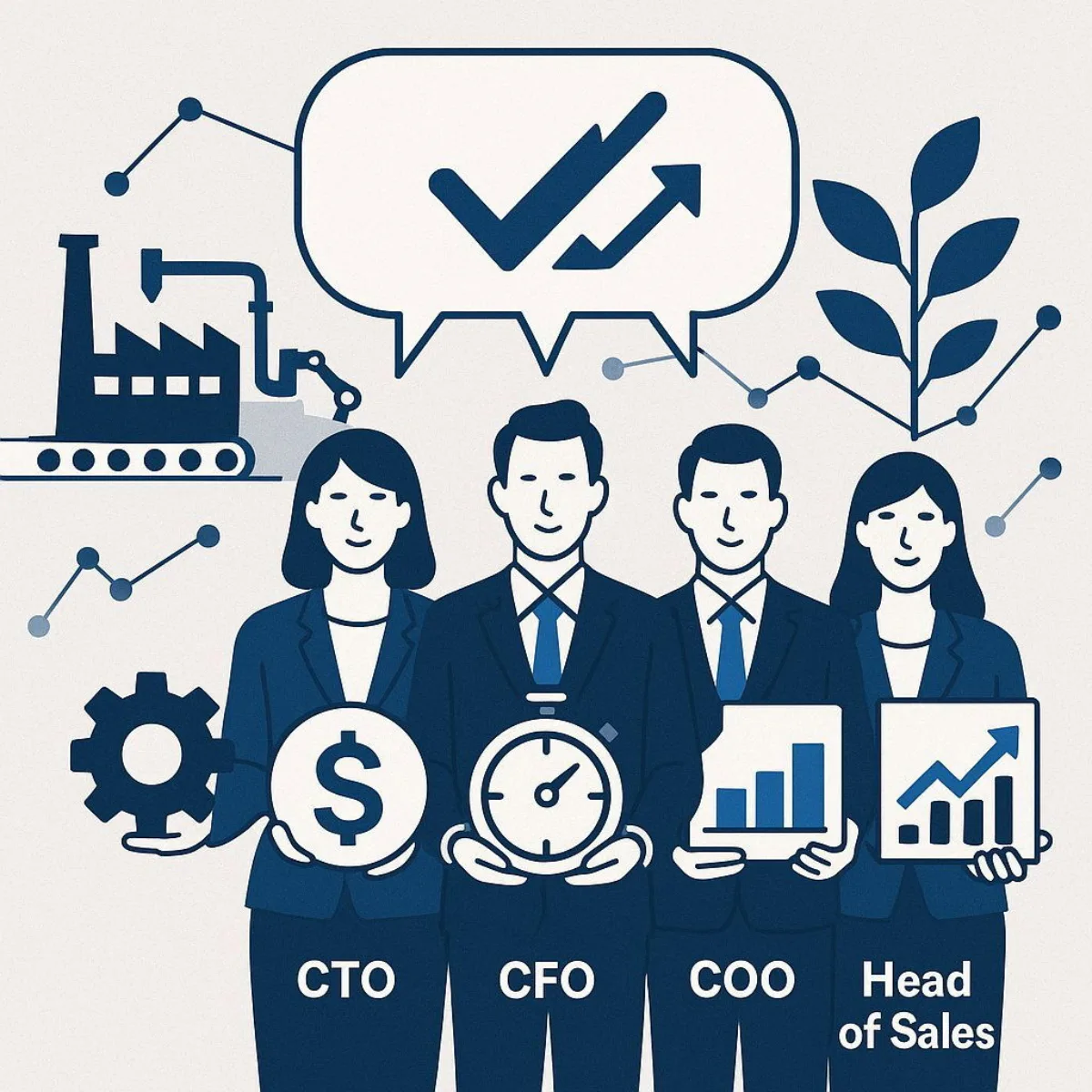
Why Manufacturing Teams Resist Software—and How to Overcome It
August 14, 2025 / Bryan ReynoldsYour Team Resists New Tech. Is Your Software the Problem—Or the Solution?
The $2 Trillion Question in Manufacturing

The numbers are staggering. Global spending on digital transformation is on a trajectory to reach nearly $4 trillion by 2027. Yet, despite this colossal investment, the landscape is littered with failures. As many as 70% of all digital transformation programs fail to achieve their stated goals. This isn't just a missed opportunity; it's a monumental waste of capital, estimated at a jaw-dropping $2.3 trillion globally. For any executive, this begs a frustrating question: why?
The answer, it turns out, has very little to do with the technology itself. The real culprit is much closer to home. Research from PwC reveals a stunning truth: of the transformations that fail, a full 70% are due to a lack of user adoption and behavioral change. The expensive, state-of-the-art system you've staked your company's future on is being undermined not by market forces or technical glitches, but by the very people it was meant to empower.
This leads to the central question for every manufacturing leader navigating this complex transition: "How can the very software causing this friction become the ultimate solution to overcoming resistance?"
The answer lies in a fundamental shift in perspective. Resistance is not a personality flaw to be crushed; it is a data point to be analyzed. It signals a disconnect between the technology you've chosen and the people you're asking to use it. By strategically selecting software with human-centric features and implementing it with an empathetic, modern methodology, you can transform technology from a source of conflict into a catalyst for adoption and a powerful driver of business value. This article will show you how.
Decoding Resistance: Why Your Best People Push Back on New Systems
When faced with pushback, the temptation is to label employees as "resistant to change" and move on. This is a critical mistake. Resistance is rarely irrational. It's a natural, predictable human reaction to uncertainty, perceived threats, and, most often, flawed change initiatives from the top. It's not sabotage; it's a logical response rooted in deep-seated psychological drivers and amplified by organizational missteps.
The Psychological Drivers (The "Feel" Component)
At its core, resistance is an emotional response. Understanding these feelings is the first step to addressing them.
Fear of the Unknown & Job Security: This is the most potent driver. The introduction of advanced robotics, AI, and automation naturally leads employees to wonder, "Will my job be replaced?". They fear their hard-won skills will become obsolete, their compensation will change, or they will be deemed redundant. This anxiety is magnified when they are kept in the dark and excluded from the decision-making process, making them feel like the change is happening
to them, not with them.
- Fear of Incompetence: Consider an operator who has been an expert on a legacy system for 20 years. They know its every quirk and can make it sing. A new system threatens this expertise. They fear making mistakes, looking foolish in front of peers, and losing their status as a go-to expert. This isn't just about pride; it's about their perceived value to the organization.
Loss Aversion & Status Quo Bias: Behavioral psychology teaches us that the pain of losing something is twice as powerful as the pleasure of an equivalent gain. This is
loss aversion. Employees are not just gaining a new system; they are losing familiar processes, established relationships, and a sense of control over their work. Compounding this is the endowment effect, where people place a higher value on things they already possess. Their current, comfortable workflow—even with its flaws—feels more valuable and safer than the promise of a new, unproven system.
The Organizational Failures (The "Think" Component)
These psychological fears don't exist in a vacuum. They are validated and amplified by concrete failures in strategy and execution from leadership.
- Lack of a Clear Strategy: When leadership fails to articulate a clear and compelling "why" behind the change, the entire initiative feels aimless. A vague goal of "digitalizing the plant floor" leads to confusion, wasted resources, and inefficient implementation. If the vision isn't crystal clear in the C-suite, it will be pure chaos on the shop floor. This is a top pitfall for manufacturers embarking on digital transformation.
- Poor Communication & Leadership Misalignment: Even a great strategy is useless if it's not communicated effectively. When leaders are disengaged, send mixed messages, or show a lack of conviction, it erodes employee trust and confidence. A common failure point is a disconnect between executive enthusiasm and the workforce's understanding of what the change means for them personally.
- Automating Broken Processes: Perhaps the most fatal error is believing technology will magically fix underlying operational problems. It won't. Technology doesn't fix chaos; it just makes it happen faster. Implementing a shiny new ERP system on top of broken, inefficient, or undocumented business processes is a guaranteed recipe for failure. The business process blueprint must drive the technology selection, not the other way around.
The crucial takeaway here is that resistance is not the problem; it is a symptom of a deeper issue in your strategy, your communication, or your choice of technology. It's the most valuable, unfiltered feedback you will ever receive. Instead of trying to suppress it, a savvy executive should listen to it, diagnose the root cause, and fix the underlying organizational failure. This transforms a "people problem" into a solvable process and strategy problem.
Table: The Anatomy of Resistance: A Diagnostic for Leaders

To help decode the signals from your team, use this framework to connect what you're seeing on the floor to the real issue that needs your attention.
| What You See (The Symptom) | What Your Employee Feels (The Fear) | What It Really Means (The Root Cause) |
|---|---|---|
| Vocal complaints, negativity, rumors | Fear of job loss, reduced status, or obsolescence. | Lack of a clear, compelling vision for future roles. Leadership has failed to communicate the "why" and what the future holds for the workforce. |
| Low software usage, avoidance, procrastination | Fear of looking incompetent, making mistakes, or failing. | The software has poor UI/UX. It is not intuitive or user-friendly. Training is inadequate, nonexistent, or fails to build confidence. |
| Creating manual workarounds and clinging to old tools | Fear of losing control and autonomy over their work processes. | The new system is too rigid and doesn't fit the workflow. Users were not involved in the design and selection process, so the software doesn't match their needs. |
| Inter-departmental friction, data silos persist | Fear of disruption to established, functional team processes and relationships. | Lack of a unified digital strategy and executive alignment. The project is attempting to automate chaos without first standardizing processes across the organization. |
The First Line of Defense: Designing Software People Want to Use
The first and most powerful tool for preventing resistance is the software itself. The user interface is the front line of your change initiative. If that first impression is one of complexity, confusion, and frustration, it validates every employee's worst fears. It sends a clear message: "This new system will make your job harder, not easier." While often overlooked in industrial software, a focus on user experience (UX) and user interface (UI) design is a critical, proactive strike against resistance.
Principle 1: Intuitive UI/UX is Non-Negotiable
An intuitive interface is one a user can understand and operate without needing constant help or a thick manual. It reduces the mental effort (cognitive load) required to perform tasks, which in turn minimizes errors, cuts down on training time, and boosts operational efficiency.
Key elements of an intuitive design for the manufacturing environment include:
- User-Centricity from Day One: UX/UI cannot be an afterthought bolted on at the end of development. It must be a core part of the planning process, starting with a deep analysis of the real-world context of the plant floor. Will operators be wearing gloves while using a touchscreen? Is the environment noisy, poorly lit, or subject to vibrations? These factors must inform the design of buttons, fonts, and layouts.
- Simplicity and Consistency: The interface should be clean, uncluttered, and predictable. An icon, a term, or a color should mean the same thing on every screen. This consistency allows users to build a mental model of how the system works, making them feel competent and in control much faster.
- Recognition Over Recall: A well-designed UI presents users with clear options and guides them through processes, rather than forcing them to recall complex commands or procedures from memory. This principle of "recognition over recall" dramatically lowers the mental barrier to using the software, making it feel less intimidating and more like a helpful tool.
Principle 2: The Software Should Be the Teacher (In-App Training)

Traditional training methods—pulling people off the line for days of classroom sessions—are expensive, disruptive, and often ineffective. Knowledge retention plummets once employees are back in their normal environment. Modern software can and should have training built directly into the user experience, empowering users to learn at their own pace and at their moment of need.
Effective software-embedded training tools include:
- Interactive Walkthroughs: These are not passive video tours. Interactive walkthroughs are step-by-step guides that actively prompt users to click buttons and enter data within the live application. This is "learning by doing," the most effective way to build muscle memory and true competence.
- Self-Serve Resource Centers: This is an on-demand library of tutorials, short videos, and "how-to" guides accessible from a help menu within the application itself. When a user gets stuck, they can find the answer immediately without having to track down a supervisor or submit a support ticket. This fosters autonomy and reduces frustration.
- User Checklists: Especially valuable during onboarding, these are guided lists of essential tasks that direct a new user to the software's core features. Completing the checklist helps them experience the value of the system quickly, accelerating them to the "aha!" moment where they understand how it makes their job better.
Investing in software with superior UI/UX and embedded training is not merely an IT expense; it is a direct and powerful investment in your change management program. The single biggest driver of digital transformation failure is low user adoption, which itself is driven by fear and frustration. A higher upfront investment in a user-friendly system that builds its own user competence directly mitigates this primary risk. For the CFO, this isn't a "premium feature" cost; it's a strategic insurance policy that protects the entire multi-million dollar investment from ending up on the 70% scrap heap. This aligns the CTO's choice of technology with the COO's need for a smooth operational transition and the CFO's imperative for a positive ROI.
Making the 'Why' Visible: How Real-Time Dashboards Drive Adoption

Leadership can talk about "improving efficiency" and "increasing throughput" in meetings and memos, but to a line operator, these are abstract corporate buzzwords. To truly win hearts and minds, you must make the benefits of the new system tangible, visible, and personal. Real-time performance dashboards are the ultimate "show, don't tell" tool, transforming abstract goals into a live, undeniable reality on the plant floor.
A static report delivered a week late is an autopsy; a real-time dashboard is a live EKG, providing an instant, dynamic pulse of the factory. This continuous stream of information makes the value of the new digital system self-evident, creating a powerful, data-driven case for change that resonates far more than any speech.
The power of a well-designed dashboard system lies in its ability to deliver role-specific information, making it relevant to everyone from the shop floor to the top floor.
- For Plant Floor Operators: Instead of cycling through multiple screens or relying on gut feel, an operator gets a single, comprehensive view of their production line. Visual alerts instantly highlight anomalies like pressure drops or temperature spikes, allowing for faster fault detection. This reduces their cognitive load and empowers them to shift their focus from reactive firefighting to proactive optimization.
- For Engineers: Process and quality engineers can track key metrics like Overall Equipment Effectiveness (OEE), cycle times, and quality indicators live. This enables rapid identification of performance trends and allows for immediate "Plan-Do-Check-Act" cycles. They can adjust a parameter and see the impact on production in seconds, not wait for the end-of-shift report.
- For Management & Executives: High-level Key Performance Indicators (KPIs) on production output, order fulfillment, energy usage, and downtime are aggregated into strategic dashboards. This allows leadership to make informed decisions based on what is happening right now, not what happened last week. This proactive management capability is a game-changer.
This visibility isn't just about aesthetics; it drives measurable business outcomes. A McKinsey study found that manufacturers leveraging real-time analytics can improve operational efficiency by up to 25%, while other reports show digital tools can cut machine downtime by up to 50%.
Beyond the hard numbers, real-time dashboards function as a powerful culture-building tool. Resistance is often born from departmental silos, mistrust, and a lack of shared understanding. A shared, real-time dashboard becomes the "single source of truth" that everyone—operations, maintenance, engineering, and management—can see and trust. When an operator's dashboard shows a machine fault and the maintenance team's dashboard shows the same alert, the conversation immediately shifts from blame and finger-pointing to collaborative, data-driven problem-solving. This transparency empowers teams to take ownership of their performance, fostering accountability and a shared sense of purpose. Over time, this data-driven communication becomes the new cultural norm, organically replacing the old habits and "we've always done it this way" mentality that legacy systems perpetuated. The dashboard doesn't just support the new process; it actively builds the new culture required to sustain it.
The Implementation Playbook: Mitigating Risk and Building Momentum
How you roll out new software is just as important as what you roll out. The implementation methodology is not a technical footnote; it is a core part of your change management strategy. Choosing the right approach can proactively build momentum and dismantle resistance, while the wrong one can create a tidal wave of fear and backlash that sinks the entire project.
Choosing Flexibility Over Rigidity (Agile vs. Waterfall)
The manufacturing world is built on the principles of the Waterfall method: a linear, sequential process where one step must be complete before the next begins. This works for building a car, but it's a notoriously poor fit for implementing complex software. The Waterfall approach is rigid, slow to deliver value, and cannot easily accommodate the inevitable changes and discoveries that arise during a software project.
The modern alternative is the Agile methodology. Agile breaks the project into small, manageable, time-boxed "sprints" (typically 1-4 weeks long). It values flexibility, continuous feedback from users, and adapting to change. This iterative process allows for the early identification of risks, faster delivery of a working product (even if it's a minimum viable product, or MVP), and ensures the final result actually meets the users' needs, because they are involved throughout the process.
Reducing Shock to the System (Phased Rollout vs. Big Bang)

The implementation strategy directly impacts the level of disruption your organization will face.
The High-Risk Gamble (Big Bang): This approach involves switching the entire organization to the new system at a single point in time. It can be faster and potentially cheaper
if it succeeds. However, it carries an enormous risk of catastrophic failure. It's nearly impossible to conduct full, end-to-end testing in a complex environment, meaning major issues may only appear after go-live, when the entire business is dependent on the new system. This sudden, massive change is precisely the kind of shock that triggers the "too much change at once" backlash from employees.
- The Strategic Approach (Phased Rollout): This involves introducing the new system gradually—perhaps module by module, by a single production line, or site by site. This approach allows the project team to learn, fix bugs, and refine processes in smaller, more manageable chunks. It gives employees more time to adapt, building their confidence and creating a track record of success with each phase. While it can incur higher temporary costs from running two systems in parallel and requires longer project management, this is often a small price to pay to avoid a project-killing failure.
Proving the Concept with a Pilot Program
The ultimate risk mitigation strategy is to run a pilot project before committing to a full-scale rollout. A pilot is a small-scale, controlled test of the new software in a real-world manufacturing environment. Its benefits are immense:
- Test Viability: It provides definitive proof of whether the software can actually meet your business requirements and deliver value before you make a massive financial commitment.
- Identify Champions: In any organization, there are influencers and early adopters who are eager for change. A pilot program helps you identify these individuals. They will become your most credible champions and a vital resource during the wider rollout.
- Gather Critical Feedback: A pilot allows you to get honest, actionable feedback from a small, manageable group of real users. This feedback is invaluable for refining the system configuration, the training plan, and the communication strategy before it goes to the entire company.
- Build the Business Case: A successful pilot provides concrete data, success stories, and tangible ROI metrics. This evidence is your most powerful tool for winning over skeptical stakeholders and securing the budget and buy-in for the full implementation.
Chart: Implementation Strategy: Risk vs. Reward
This table summarizes the trade-offs to help guide your strategic decision.
| Evaluation Criteria | Big Bang Implementation | Phased Implementation |
|---|---|---|
| Risk of Catastrophic Failure | High | Low |
| Level of User Disruption | Very High (All at once) | Moderate & Staggered |
| Opportunity for Learning & Adjustment | Low (Post-launch only) | High (Between phases) |
| Likelihood of User Adoption | Lower (High anxiety) | Higher (Gradual adaptation) |
| Implementation Timeline | Shorter | Longer |
| Total Project Cost | Potentially Lower (if successful) | Potentially Higher (due to temporary interfaces & longer project management) |
Ultimately, the choice of implementation methodology is a powerful, non-verbal communication to your workforce. A "Big Bang" approach implicitly signals a top-down, command-and-control culture that says, "This is happening to you. Adapt or else." This validates fears and breeds resentment. A "Phased" or "Pilot-First" approach, however, sends a message of empathy. It says, "We know this is a significant change, and we're going to do this together, step-by-step. Your feedback is critical to our shared success." This approach builds the psychological safety and trust that are essential for any successful transformation, proactively dismantling resistance before it can take root.
The Executive's Role: Unifying the C-Suite to Champion the Change
Resistance thrives in the fertile ground of ambiguity. When employees hear different stories from different leaders or sense a lack of conviction from the top, they will default to skepticism and inaction. A successful transformation demands a single, powerful, and unified narrative, championed in unison by the entire C-suite. Each executive must champion the change through the lens of their own priorities, creating a holistic business case that resonates across the organization.
The CTO's Mandate: From Technologist to Business Strategist
The modern CTO's role is not just to manage IT infrastructure but to drive business strategy through technology. They must champion a technical vision that is explicitly tied to business outcomes, focusing on how technology solves concrete challenges, not just on the tools themselves. Their key priorities include ensuring infrastructure agility to support new demands, leveraging AI and machine learning for predictive insights, and selecting scalable, future-proof platforms that won't become legacy problems in five years.
The CFO's Mandate: From Cost-Cutter to Value-Creator
The CFO is under constant pressure to deliver faster and more demonstrable ROI from technology investments. Long, multi-year implementation cycles with ambiguous benefits are no longer acceptable. To win their enthusiastic support, the business case must be built on hard, quantifiable metrics.
- Cost Reduction: Show how automation can slash invoice processing costs by up to 70%.
- Productivity Gains: Highlight case studies showing a 50% productivity boost in AP teams after automation and data indicating that stress-free software can save each employee an average of 2.6 hours per week.
- Hard ROI: Present evidence from platforms that delivered a 158% ROI over three years with a payback period of less than six months.
The COO's Mandate: From Firefighter to Proactive Optimizer
The COO's primary concern is operational continuity. Their biggest fear is disruption to production. The implementation plan, particularly the choice of a phased or pilot-first approach, is critical to earning their trust. The benefits to highlight for the COO are direct and impactful: real-world examples show that digital tools can reduce unplanned downtime by 40%, increase line throughput by 10-30%, and improve labor productivity by 15-30%.
The Head of Sales' Mandate: From Relationship Manager to Tech-Enabled Growth Driver

Sales leaders are perpetually frustrated by essential tools, like CRMs, that their teams fail to utilize effectively. They need technology that is easy to adopt and provides clear value. The new system must be championed as a tool that streamlines prospecting (e.g., with AI-driven insights), improves sales forecasting with real-time production data, and provides better data for effective sales coaching. If you’re interested in the tangible impact of AI-driven insights on business growth, you might also consider reading GPT-5 for Business: The Executive Playbook for Strategic AI Integration for an executive-level perspective on leveraging next-generation AI in sales and forecasting.
When each executive champions the new software through their own lens, it creates a powerful, self-reinforcing cycle of value that accelerates adoption across the entire organization. It starts with the CTO selecting an intuitive, dashboard-driven system. The COO sees a pilot program succeed, measurably reducing downtime on a critical line. The CFO then sees the hard data from that pilot—quantifiable cost savings and increased output—and becomes a vocal financial champion for the broader rollout. The Head of Sales sees the new ERP integrating seamlessly with their CRM, providing better demand forecasting, and champions its use among the sales team. This unified, multi-faceted advocacy from the top, grounded in proven value for each function, creates unstoppable momentum that cascades through the organization, making adoption feel not just inevitable, but desirable.
Conclusion: Turning a Resisted Tool into a Valued Teammate
The narrative that employee resistance is the primary obstacle to digital transformation is both pervasive and profoundly misleading. Resistance is not the disease; it is a symptom. It is a clear signal that there is a fundamental flaw in the technology chosen, the strategy deployed, or the communication from leadership. The cure, therefore, lies not in forcing compliance, but in a holistic approach that puts people at the very center of the digital strategy.
Success rests on three core pillars:
- Choose Empathetic Software: The journey begins with selecting systems designed for humans, not just for machines. Prioritize software with intuitive interfaces, user-centric design, and built-in training and support that empowers employees rather than frustrating them. For more information on selecting enterprise software that truly fits your organization, read Event Sourcing Explained: The Pros, Cons & Strategic Use Cases for Modern Architects, which explains when tailored solutions can streamline both adoption and long-term business value.
- Implement with Empathy: Abandon rigid, high-risk implementation models. Embrace modern, flexible methodologies like phased rollouts and pilot programs. These approaches reduce fear, build trust, and turn employees into active participants in their own transformation. For a closer look at how these approaches play out in real scenarios, see The Replit AI Disaster: A Wake-Up Call for Every Executive on AI in Production—a story illustrating the consequences of ignoring proper rollout and governance.
- Lead with a Unified Voice: Ensure the entire C-suite is aligned and can articulate the "why" behind the change in terms of clear, functional benefits for every part of the business. This creates a powerful, unified message that leaves no room for ambiguity or skepticism. This is deeply explored in The Executive’s AI Playbook: Building, Funding & Scaling Startups in 2025, emphasizing the role of leadership alignment in successful technology transformations.
Ultimately, the decision to invest in new manufacturing software is not just a technology purchase; it is a commitment to a new way of working. By making your people the focal point of your digital strategy, you don't just buy a tool; you build a more resilient, efficient, and competitive organization. You transform a resisted piece of software into a valued and indispensable teammate in your journey toward the future of manufacturing. For additional guidance and frameworks to ensure a successful and sustainable transformation, explore Agentic SDLC: The AI-Powered Blueprint Transforming Software Development.
Supporting Links
- Prosci: (https://www.prosci.com/methodology/adkar) (For a deeper dive into a leading change management framework).
- McKinsey & Company: Getting digital transformation right in resource-heavy industries (For executive-level strategic context on industrial transformation).
- Gartner: (https://manufacturingdigital.com/articles/gartner-making-smart-manufacturing-smarter) (For insights on smart factory trends and challenges).
- Deloitte: 2024 Manufacturing Industry Outlook (For current industry pressures and priorities).
- Interaction Design Foundation: ( https://www.interaction-design.org/literature/article/nielsen-s-10-usability-heuristics-for-user-interface-design ) (A foundational text on the principles of intuitive UI design).
About Baytech
At Baytech Consulting, we specialize in guiding businesses through this process, helping you build scalable, efficient, and high-performing software that evolves with your needs. Our MVP first approach helps our clients minimize upfront costs and maximize ROI. Ready to take the next step in your software development journey? Contact us today to learn how we can help you achieve your goals with a phased development approach.
About the Author

Bryan Reynolds is an accomplished technology executive with more than 25 years of experience leading innovation in the software industry. As the CEO and founder of Baytech Consulting, he has built a reputation for delivering custom software solutions that help businesses streamline operations, enhance customer experiences, and drive growth.
Bryan’s expertise spans custom software development, cloud infrastructure, artificial intelligence, and strategic business consulting, making him a trusted advisor and thought leader across a wide range of industries.


